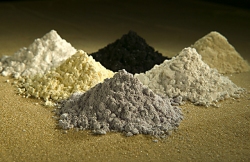
November Editorial
The global survey of 'rare earths'.

November Editorial
The global survey of 'rare earths'.
|
In our earlier article on 'rare earths' we discussed the importance of those metals, which are essential to many modern technological products from superconductors and lasers to hybrid car components. Increasing use of these metals means that the demand is high and increasing. China is still pretty much the only country which produces these rare earth elements (REE) on an industrial scale. Indeed the USA imports its REE almost exclusively from China. The problem is that China wants to use the threat of restricting exports of REE to leverage trade advantages from the USA. This has created an urgent for new sources of these metals.
|
In 2009 the USA launched a geological survey of its of domestic rare earth deposits. This was a part of a much wider global survey intended to provide an overview of available sources of REE and how those might be developed in future. The report has recently been published. The report shows that REE certainly not exclusive to China. In fact they are distributed worldwide with reserves of some 13 million metric tones of proven and exploitable resources in the USA alone. Other countries with large deposits, not including China, are the Commonweath of Independent States (19 million metric tones), India (3.1 million) and Australia (5.4 million). There are estimated 22 million metric tonnes in total of REE outside the above countries. |
In the USA significant deposits have been found in 14 states, namely: California, Alaska Colorado, Florida, Georgia, Idaho, Illinois, Missouri, Nebraska, New Mexico, New York, North Carolina, and South Carolina. The largest deposits with mining potential were found at Mountain Pass in California, Bokan Mountain in Alaska and Bear Lodge in Wyoming.
REE can be found in hard rocks, heavy metal rich sandy sediments and phosphate deposits, the latter predominantly in the southern United States. The deposits found in hard rocks are most economically viable for mining.
Last year the USA’s domestic consumption of REE was 11 thousand metric tones. This is likely to increase because rare earths are essential components in many developing alternative energy technologies. For example REEs are used in electric vehicles, energy-efficient lighting and wind power. New projects for REE mining are already underway in the USA, Canada and Australia. Although many of the deposit sites listed above still need to be confirmed, just the confirmed deposits should supply enough REE to satisfy demand for years to come. The question of whether mining will be economically viable will depend on future trends. But it is clear that substantial deposits exist outside China, which effectively blunts the use of REEs as a trade weapon. So it may be that the survey has succeeded in its purpose even if none of the new discoveries are ever mined.
| _______________________________ | ||||
| Home | | | Shopping | | | Database |
© Biscuit Software 2004-2015
All rights reserved